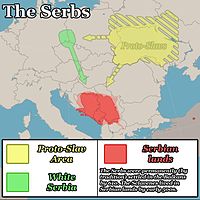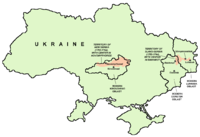- List of Serb countries and regions
-
Part of a series of articles on
Serbs
 Former Yugoslavia:
Former Yugoslavia:
Serbia (Kosovo • Vojvodina)
Bosnia & Herzegovina (RS)
Croatia
Republic of Macedonia
Montenegro
Slovenia
Other:
Albania · Greece · RomaniaAustria · France · Germany
Hungary · Italy · Sweden · Switzerland
United Kingdom
North America
Canada · United States
Oceania
Australia · New Zealand
South America
Argentina · Brazil · ChileReligion
(Slava · Christmas traditions)
Kinship · Clans
Art · Architecture · Music · Cinema
Costume · Symbols
Literature · Epic poetry
Cultural Heritage sites
Sport · Cuisine · DancesRelated nationsMain article: History of the SerbsThis is a list of Serb countries and regions throughout history, called Serbian lands[1] by historians (Serbian: Српске земље, Srpske zemlje). It includes empires, countries, states, provinces, regions and territories that have or had in the past one of the following characteristics:
- An ethnic Serb majority
- Serbs are an official, constitutional or titular nation
- Serbian as an official language
- A Serb ruling class or dynasty
It also includes states of Prehistoric Serbia (States within or part of present Serbian territory).
Contents
Prehistoric Serbia
- Moesia, Roman region and province 75 BC-3rd century
Historical political entities
Early
Map Name Years Area Notes 
White Serbia or Bojka ? The location of White Serbia has been disputed. It has been described as: Traditional homeland of the White Serbs in Europe.[7] Serbian Sklavinia fl. 610-641 (680) Balkans Monarchy
Image Map Name Years Area Notes 

Serbian Principality ~768-969 Serbia
BiH
Montenegro
Croatia
AlbaniaHeld by the Vlastimirović dynasty. Časlav (r. 927-960) liberated the Serbian principalities from Bulgarian rule in 927. He enlarged Serbia, uniting the tribes of Bosnia, Herzegovina, Old Serbia and Montenegro (incorporated Zeta, Pagania, Zahumlje, Travunia[8], Konavle, Bosnia and Rascia into Serbia, "ι Σερβλια").[9][10] He took over regions previously held by Michael of Zahumlje, who disappears from sources in 925.[8] De Administrando Imperio describes his realm: the shores of the Adriatic Sea, the Sava river and the Morava valley as well as today's northern Albania.[10] 
Serbian Principality [Duklja] 1000-1148 Serbia
BiH
Montenegro
Croatia
Albania

Serbian Grand Principality [Rascia] 1091-1217 Serbia
BiH
Montenegro
Croatia
Albania
Macedonia

Serbian Kingdom 1217-1345 Serbia
BiH
Montenegro
Croatia
Albania
Macedonia
Serbian Empire 1345-1371 Serbia
Macedonia
Montenegro
Albania
Greece
BulgariaFall of the Serbian Empire Serbian Despotate In Exile / Short-lived / Titular
- Serbian Empire of Jovan Nenad (1526–1527), Duchy of Syrmia of Radoslav Čelnik (1527–1530)
Modern political entities
- Military Frontier (1579–1881)
- Habsburg Serbia (1718–1739)
- Kingdom of Slavonia (1745–1868)
- New Serbia (1752–1764)
- Slavo-Serbia (1753–1764)
- Koča's Frontier (1788–1791)
- Kingdom of Croatia-Slavonia (1868–1918)
- Karađorđe's Serbia (1804–1813), Princedom of Serbia (1817–1882), Kingdom of Serbia (1882–1918)
- Serbian Voivodeship (1848–1849), Voivodeship of Serbia and Tamiš Banat (1849–1860)
- State of Slovenes, Croats and Serbs (1918)
- Banat Republic (1918)
- Kingdom of Serbs, Croats and Slovenes (1918–1929), Kingdom of Yugoslavia (1929–1941)
- Serb-Hungarian Baranya-Baja Republic (1921)
- Kingdom of Serbia (1941–1944)
- Banat (1941–1944)
- Republic of Užice (1941)
- Democratic Federal Yugoslavia (1945–1946), Federal People's Republic of Yugoslavia (1946–1963), Socialist Federal Republic of Yugoslavia (1963–1992)
- People's Republic of Serbia (1945–1963), Socialist Republic of Serbia (1963–1990), Republic of Serbia (1990–1992)
- Autonomous Province of Vojvodina (1945–1974), Socialist Autonomous Province of Vojvodina (1974–1990), Autonomous Province of Vojvodina (1990–1992)
- Autonomous Region of Kosovo and Metohija (1945–1974), Socialist Autonomous Province of Kosovo (1974–1990), Autonomous Province of Kosovo (1990–1992)
- People's Republic of Bosnia and Herzegovina (1945–1963), Socialist Republic of Bosnia and Herzegovina (1963–1990), Republic of Bosnia and Herzegovina (1990–1992)
- People's Republic of Croatia (1945–1963), Socialist Republic of Croatia (1963–1990)
- People's Republic of Serbia (1945–1963), Socialist Republic of Serbia (1963–1990), Republic of Serbia (1990–1992)
- Republic of the Serbian People of Bosnia and Herzegovina (1992), Serb Republic (1992–1995)
- Autonomous Area of Frontier (1991), Serbian Autonomous Area of Bosnian Frontier (1991–1992)
- Serbian Autonomous Region of North-Eastern Bosnia (1991–1992)
- Serbian Autonomous Region of Romanija (1991–1992)
- Serbian Autonomous Region of Eastern Herzegovina (1991–1992)
- Republic of Serbian Frontier (1991–1995)
- Serbian Autonomous Region of Knin Frontier (1990), Serbian Autonomous Area of Frontier (1990–1991)
- Serbian Autonomous Area of Western Slavonia (1991)
- Serbian Autonomous Area of Eastern Slavonia, Baranja and West Srem (1991), United Nations Transitional Administration for Eastern Slavonia, Baranja and Western Syrmia (1995–1998)
- Federal Republic of Yugoslavia (1992–2003), State Union of Serbia and Montenegro (2003–2006)
- Republic of Serbia (1992–2006)
- Autonomous Province of Vojvodina (1992–2006)
- Autonomous Province of Kosovo and Metohija (1992–1999)
- UN-administered Kosovo (1999–Present)
- Republic of Serbia (1992–2006)
Present political entities
 Serb-inhabited political entities at the end of the 20th century[citation needed]
Serb-inhabited political entities at the end of the 20th century[citation needed]
This is the list of the current states and regions where Serbs are in absolute or relative ethnic majority, are one of the constitutional or recognized peoples or Serbian language is official:
-
-
- Republic of Kosovo (partially-recognised state)
-
- Bosnia and Herzegovina (constitutive nation)
- Montenegro (32% of the population, 63% speaks Serbian)
- Croatia (minority, 4% of the population) [11]
- Republic of Macedonia (minority) [11]
- Hungary (minority) [11]
- Albania (minority) [11]
- Romania (minority) [11]
- Slovakia (minority) [11]
- Czech republic (minority) [11]
Serbian lands-term
In 1857, while traveling across "Ancient Serbia", Alexander Fedorovich Gilferding (1831-1872), a Russian Slavist and travel writer of German origin, notes that "an Orthodox Serb, wherever he might live – in Bosnia, Herzegovina, Dalmatia, Hungary, Principality of Serbia – has, besides a church, one great homeland, Serbian land, which is, to tell the truth, divided among many masters, but it exists as an ideal, as the land of the unified Orthodox Serbian nation. He has his own oral tradition, folklore; he knows about Serbian Saint Sava, Serbian Emperor Dušan, Serbian martyr Lazar, hero Kraljević Marko. His current life rests upon the foundations of his nation and it is permeated with the previous historical life of the nation".[12]
References
- ^ E.J. Brill's first encyclopaedia of Islam 1913-1936
- ^ Google books search
- ^ Google books search
- ^ Google books search
- ^ Google books search
- ^ Google books search
- ^ Projekat Rastko Cetinje - Petar Vlahovic: The Serbian Origin of the Montenegrins.
- ^ a b The entry of the Slavs into Christendom, p. 209
- ^ The early medieval Balkans, p. 160
- ^ a b Južnoslavensko pitanje, p. 48
- ^ a b c d e f g "Information on the status of Serbian people in the neighbouring countries, Ministry for Diaspora, Republic of Serbia". Archived from the original on 2007-11-24. http://web.archive.org/web/20071124130346/http://www.mzd.sr.gov.yu/_eng/polozaj_srba_u_okruzenju.asp. Retrieved 2007-05-15.
- ^ Elements Of Ethnic Identification Of The Serbs 727
See also
- Greater Serbia, irrendentist claim to regions historically and currently populated by Serbs
- List of regions of Serbia
- List of Serbian monarchs
- History of Serbia
- History of Montenegro
- History of Vojvodina
- History of Kosovo
- History of Bosnia and Herzegovina
- History of Republika Srpska
Categories:- Serbian people
- History of Serbia
- History of the Serbs
- Serbia-related lists
- Political history of Serbia
- Historical regions in Serbia
Wikimedia Foundation. 2010.


